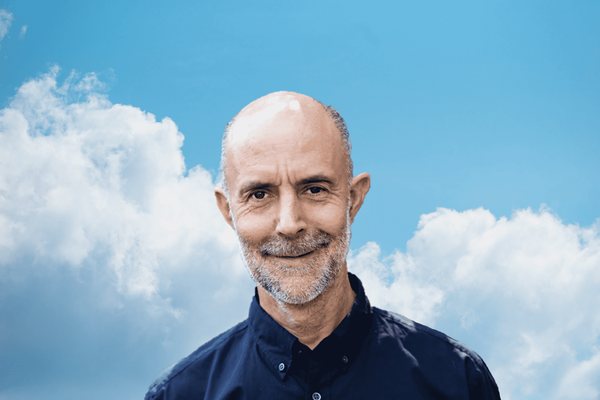Martijn Schirp • • 10 min read
Floating Through Innerspace: Why You Should Try A Sensory Underdose
Consciousness & Meditation Health & Fitness Psychedelics & Drugs

This is my sensory deprivation tank experience. Are you ready to take a trip through interspace?
You hop in the shower to cleanse yourself of your accumulated dirtiness. A mandatory ritual before entering the silent sanctuary.
You walk to the futuristic egg, leaving a few wet footprints behind.
You plug in some earplugs before you dip your toes in the water.
The sensation you feel is neither hot nor cold. The water matches exactly the temperature of your body.
The water does feel different somehow. A bit jelly-like. You know this is because the total volume of the water-like mixture consists of 25% epsom salt (In chemical terms 400kg/850lbs magnesium sulfate – MgSO4·7H2O, on average).
This cool chemical brings the floatation to the tank.
By increasing the density of the water, you increase the force necessary to cause you to sink, to displace enough fluid. At a certain point, the force of gravity dragging your body down is not enough to push away the mixture completely and hence, you are now floating.
Beyond that, epsom salt is also a source of muscle relaxation, capillary dilation, and endorphin generation. Nice.
This epsom salt is one reason for the earplugs. The other reason is for cancelling out any last remnants of air waves making it through your auditory canal. Relaxed.
Thinking about all this salty business, you think you should be really careful not to rub your face with your hands after you have entered the tank. That would be like eating jalapeño peppers with your eyes.
You notice a curious mix of excitement and nervousness. Excited because of all the fantastic stories and benefits you’ve read, nervous because you will be confined to a small bathtub-like cocoon built with the sole purpose of not allowing any light or sound to go in. Scary.
People can go crazy like that, you know.
Not that you are really afraid to be one of those people, mind you. It is just the understanding that the idea of floating in itself should be enough to give rise to an uncomfortable sense of claustrophobia in anyone.
You close the lid and test the limits of your buoyancy.
Once you have positioned yourself horizontally, the sensation is quite peculiar and not at all unpleasant. A comparison with floating through outer space feels wrong, as you can definitely notice that gravity is still present.
But there something about the feeling that is unlike anything you have experienced before.
First dreamt up and designed by Dr. John C. Lilly, the sensory deprivation tank made it possible to do a truly epic experiment on consciousness. Epic, not because of some grand scale, but epic due to the uniqueness of the conditions the tank provides.
Subtract any external sensory input from your experience, and what will remain?
Floating in the tank after a busy day’s work brings a great relief. Suddenly all of the stimulation of holding oneself upright against the force of gravity disappears. One realizes that a good deal of the fatigue accumulated during the day is caused by resisting a gravitational field.
From a neurophysiological standpoint, one has immediately freed up very large masses of neurons from the necessity of constant computations (as to the direction of gravity, the programming by visual and acoustic inputs, by temperature changes, etcetera). For example, one’s cerebellum is now freed for uses other than balancing the body.
― John C. Lilly, The Deep Self: Consciousness Exploration in the Isolation Tank
John C. Lilly was a very interesting figure, someone who can easily be seen as the archetypal embodiment of the brilliant yet mad scientist, as he lived a life full of experimentation with his mind, his beliefs, and copious amounts of drugs. He even went so far as to claim that you need to be on ketamine to have a valuable float. (Personally, I disagree. Then again, I have not tested his claim. Yet.)
Fun mammal fact: He also tripped together with dolphins, giving himself and our mammal cousins LSD-25, in order to reduce our inter-species barriers and allow some communication to flow. You can read his account here.
Brilliant, yet mad. Yep.
His conception of the sensory deprivation tank was, clearly, a revolutionary idea.
Sometimes I wake up in the middle of the night with an idea that I want to work out, so rather than disturb my wife, I float in the tank and work out the idea at great length and in fine detail. I am then able to put it down on paper or to dictate it in the morning. For a businessperson, a scientist, a professional of any sort, this is a boon: to be able to think, free of physical fatigue of the body. The method allows one to become free within a few minutes.
― John C. Lilly, The Deep Self: Consciousness Exploration in the Isolation Tank
Now, that is awesome.
But what is it about the sensory deprivation tank that makes it so unique? Why can’t you just lie down on the floor and expect the same results?
Lilly coined the term “inperience”, as opposed to “experience”, to describe this difference.
While the magnesium sulfate water mixture carries you, it still remains a liquid, and so the semi-gooey substance presses equally on all points of contact with your body. In all other moments in our waking life, we hold tension in some parts of our body, and this easily goes unnoticed. However, during a sensory deprivation tank experience, the water just gives in. There is no physical tension that presses back. And in this context, any tension you hold is magnified to the fullest.
You can not help but be aware of the places in your body where you already anticipated a reaction to an event, in the form of a ready-ness of your nervous system to respond. A kind of existential stance.
In the float, there is a deep and natural understanding that you don’t have to react against anything.
And so you let go. You release.
No wonder a sensory deprivation tank experience is sometimes promoted as going back to that most primal of all feelings, the cosmic womb.
And while being here it is not just the body that softens.
The mind constantly calibrates its own position in relation to something else. Height in relation to the ground. Distance in relation to objects. Temperature in relation to your own heat production. Time in relation to events. And the list goes on.
We only know what up, left, inside, etc. is, because we ourselves have a left side and an inside.
But this is impossible in the sensory deprivation tank experience. There is nothing to use as a measuring stick to give a sense as to where, when and how you are. You can’t read of something how long you’ve been there. And perhaps most exciting, you lose grip of what you thought you are.
If you allow yourself to let go, and be able to let go of the letting go, time and space can dissolve.
You become the darkness that reaches out into infinity. The boundaries of your body melt with everything in your awareness.
You stop identifying with what is actually happening. And you start identifying with the space in which these things happen. Like a Figure–ground Gestalt reversal.
Of course, this is not a new phenomenon. It is just magnified due to the unique qualities of the sensory deprivation tank. Just read ‘How To Experience a Phantom Limb’ to get an idea as to what great extent your body-sense is malleable.
It is not uncommon to feel that you are floating in an infinite sea of nothingness while darkness envelops you. That the distinction between self and non-self disappear, and all that is left is the rhythm of your breath and the beginningless heartbeat of the world.
From the depths of Being, dream-like memories float up. Smells accompanied by laughing faces fill the location-less space. The distinction between the unconscious and conscious evaporates.
Some floats are defined by the grip that the universal quirk of obsessive-compulsive thinking disorder has on us. It just keeps going, endlessly reiterating the same story. Reaching the same conclusions over and over again.
But in others we fall deeper and deeper, until we are only carried by the only constant feeling of falling, and a kind of cosmic expansion, source-like, appears. Everything that remains is you, and nothing else. No escape.
“When you come back from a deep tank session,” wrote Lilly, “there’s always this extraterrestrial feeling. You have to read the directions in the glove compartment so you can run the human vehicle once more.”
As with meditation, the value of the sensory deprivation tank experience is not easily grasped by those who are limited by a hedonistic ideology.
If the increase of sensory pleasures is the deciding factor, and the tasting of infinite and ever-expanding variety and combinations of sensations is the sole purpose, then the attempt to diminish sensations to the absolute zero-point is indulgence-heresy indeed.
But those who revel in the pleasure of perspectives understand that shutting out the external information domain opens an acute sensitivity to our inner life.
What is lost is nothing but chaos. What remains is the richness of our imagination.
Without the constraints of navigating through the external world, your mind is left free to roam.
And this is exactly what the always brilliant and flamboyant Richard Feynman did, a physicist of the Nobel Prize-winning grade.
The Sensory Deprivation Tank Experience of Richard Feynman
In the must-read book, “Surely You’re Joking, Mr. Feynman!“, by Ralph Leighton, Feynman briefly describes his altered states of consciousness induced by ketamine, marijuana, and the sensory deprivation tank.
It turned out the man was John Lilly, who had earlier done some work with dolphins. He and his wife were doing some research into sense deprivation, and had built some tanks.
“Isn’t it true that you’re supposed to get hallucinations under those circumstances?” I [Richard Feynman] asked, excitedly.
“That is true indeed.”
It was right after meeting the Lilly’s that Feynman became fascinated by the prospect of experiencing hallucinations. In particular, he wished to learn in which aspects they differed from dream states. Earlier in the book he recalls how he learned to lucid dream at will when he was younger. And with the possibility of doing multiple 2.5-hour float sessions for free he was eager to continue his phenomenological experiments.
This is how he recalls his first “hallucination.” (After he met Baba Ram Das, who told him to focus on his breathing while in the tank):
I [Richard Feynman] thought: “Now where is the ego located? I know everybody thinks the seat of thinking is in the brain, but how do they know that?”
I knew already from reading things that it wasn’t so obvious to people before a lot of psychological studies were made. The Greeks thought the seat of thinking was in the liver, for instance.
I wondered, “Is it possible that where the ego is located is learned by children looking at people putting their hand to their head when they say, ‘Let me think’? Therefore the idea that the ego is located up there, behind the eyes, might be conventional!”
I figured that if I could move my ego an inch to one side, I could move it further. This was the beginning of my hallucinations.
I tried and after a while I got my ego to go down through my neck into the middle of my chest. When a drop of water came down and hit me on the shoulder, I felt it “up there,” above where “I” was.
Every time a drop came I was startled a little bit, and my ego would jump back up through the neck to the usual place. Then I would have to work my way down again. At first it took a lot of work to go down each time, but gradually it got easier. I was able to get myself all the way down to the loins, to one side, but that was about as far as I could go for quite a while.
It was another time I was in the tank when I decided that if I could move myself to my loins, I should he able to get completely outside of my body. So I was able to “sit to one side.”
It’s hard to explain—I’d move my hands and shake the water, and although I couldn’t see them, I knew where they were. But unlike in real life, where the hands are to each side, part way down, they were both to one side! The feeling in my fingers and everything else was exactly the same as normal, only my ego was sitting outside, “observing” all this.
From then on I had hallucinations almost every time I floated, and was able to move further and further outside of my body.
Here Richard touches on an often underemphasized aspect of altered states of consciousness, whether induced by psychedelics or specially designed settings like the sensory deprivation tank — that they require practice.
You can’t just hop in and expect to get the ultimate and defining experience (if there is any); there is always a bit of skill and a bit of willingness involved. Venturing out into the unknown territories of the mind is just like any other skill, in that practice is essential.
This touches upon a metaphysical discussion I’ve been having with myself in a myriad of disguises. When we experience these phenomena, do we dis-cover them? Are they already there, just waiting to be unearthed? Humming along in the background? Or do we construct them? Like a musical piece that slowly takes form after countless of iterations? Something that exists purely out of our increasing mastery of motions?
These questions are most famously applied to mathematics and the laws of physics. Do they exist independently of our human conceptions or not? But can just as easily be used to learn more about the hidden assumptions when we talk about highly subjective experiences too.
When we have an out-of-body experience, are we really something other than our bodies, looking down on our flesh cocoon? Or did we just train ourselves to have an experience that gives the sense that we are outside?
Feynman touched upon this fundamental dilemma of any knowledge when discussing his out-of-body experience.
In our numerous discussions about hallucinations on my earlier visits, I [Richard Feynman] had been trying to explain to Lilly and others that the imagination that things are real does not represent true reality. If you see golden globes, or something, several times, and they talk to you during your hallucination and tell you they are another intelligence, it doesn’t mean they’re another intelligence; it just means that you have had this particular hallucination.
The sensory deprivation tank experience magnifies this constant play of reality in which things are, at best, only half-real.
You’re wide awake, but start dreaming.
You want to open your eyes, only to discover you never closed them in the first place.
You have an out-of-body experience, though you still can move and feel the water with your hands.
Your time in the manufactured void is up, but you clearly remember just entered the tank a minute ago.
Perhaps Lilly called it inperience because it inverses everything we learned as normal, as consensus-reality.
Once you have some solid hours of a sensory deprivation tank experience under your belt, you start to understand that everything we so dearly grasp onto, just to get a sense of stable reality, is shown to be illusory.
And this, perhaps paradoxically, sets us free.










